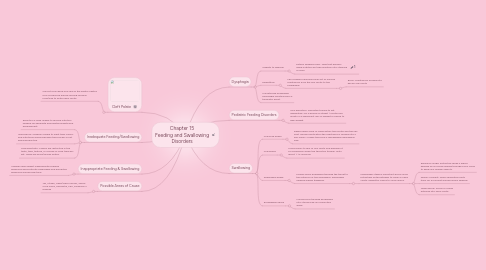
1. Cleft Palate
1.1. Cannot form good oral seal as the palate creates loss of pressure during sucking causing food/milk to enter nasal cavity.
2. Inadequate Feeding/Swallowing
2.1. Results in a child unable to receive nutrition needed for adequate and healthy growth and development.
2.2. Inefficiency: Children unable to meet their caloric and nutritional needs because the process is not being productive.
2.3. Overselectivity: Chilren are restrictive in the taste, type, texture, or volume of food they will eat. These are picky/finicky eaters.
3. Inappropriate Feeding & Swallowing
3.1. Children who exhibit inappropriate feeding behaviors demonstrate undesirable and disruptive behaviors during meal time.
4. Possible Areas of Cause
4.1. TBI, Stroke, Head/Neck Cancer, Spinal Cord Injury, Dementia, PKU, Parkinson's Disease
5. Dysphagia
5.1. Inability to swallow
5.1.1. Enteral Feeding Tube- Tube that delivers liquid nutrition by tube insertion into stomach or nose
5.2. Deglutition
5.2.1. The complex neuromuscular act of moving substances from the oral cavity to the esophagus.
5.2.1.1. Bolus: Substances formed into ball by oral cavity
5.3. Conditioned Dysphagia: Dysphagia resulting from a traumatic event.
6. Pediatric Feeding Disorders
6.1. APA definition: "persistent failure to eat adequately" for a period of atleast 1 month and results in a significant loss of weight or failure to gain weight.
7. Swallowing
7.1. Oral Prep Phase
7.1.1. Begins when food or liquid enters the mouth and the lips shut. During mastication the substance is formed into a ball "bolus." Makes the bolus a manageable swallowing size.
7.2. Oral Phase
7.2.1. Moves bolus to rear of oral cavity and prepares it for propulsion down the throat by tongue. Lasts about 1-1.5 seconds.
7.3. Pharyngeal Phase
7.3.1. Propels bolus downward through the throat to the entrance of the esophagus. Pharyngeal Swallow Reflex triggered.
7.3.1.1. Pharyngeal stage is important-bolus could potentially enter pathway to lungs or nasal cavity. Epiglottis closes to cover larynx.
7.3.1.1.1. Reflexive cough: Protective reflex n which exhaled air is forced upward through vocal cords to expel any foreign objects.
7.3.1.1.2. Apneic Moment: When respiration halts itself for a moment during normal swallow.
7.3.1.1.3. Nasal Reflux: Foods or Liquid entering into nasal cavity.
7.4. Esophageal Phase
7.4.1. Moves bolus through esophagus into stomach by an involuntary wave.
